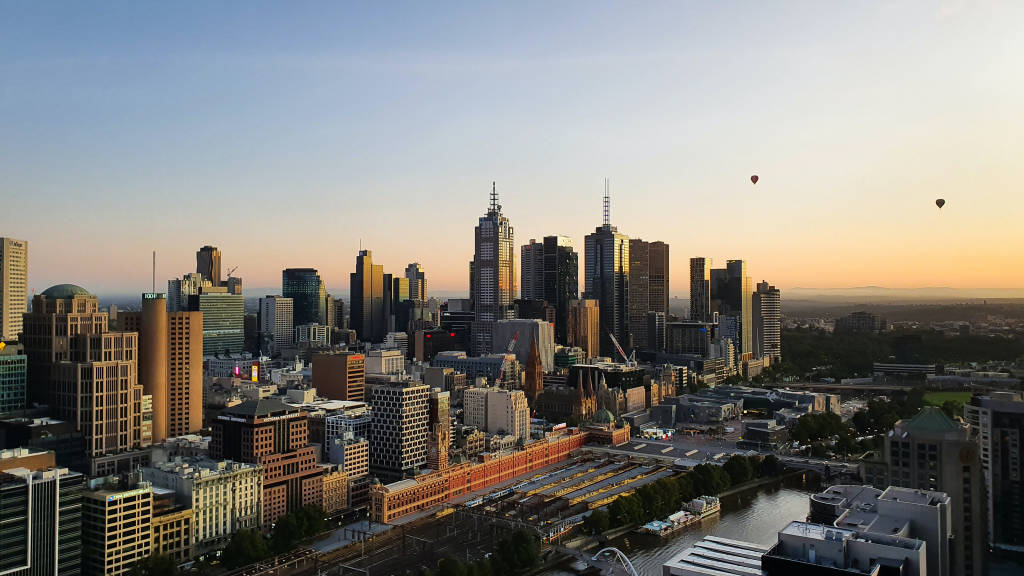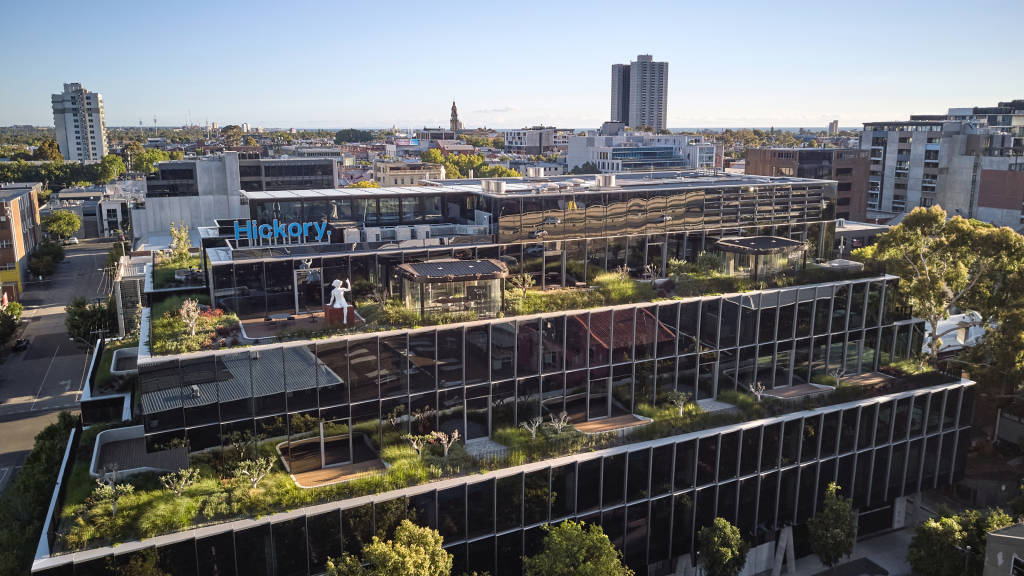Chapter 1 Melbourne: Resilience and Flexibility
The way we work is changing. This 3 part series traces the experience of Melbourne and its city dwellers across 3 contexts: Melbourne the city, the home, and the office. It investigates some of the habits and rituals formed in the midst of this paradigm shifting moment, and illustrates key macro shifts surfaced in our Steelcase Global Report about the nature of work, where that work will happen and the importance of user choice and control to productivity. Read more about findings in our Global Report, and read through to Chapter 3 of this series for information and examples about how you can build a workspace that is flexible, resilient and prepared for hybrid collaboration.

At the inward most point of Port Phillip lies the busy coastal city of Melbourne, which, at just over 4.7 million inhabitants, is Australia’s second most populous city after Sydney. The dinging bells of Melbourne’s famous trams perforate the air, and cyclists pelt down Elgin and Canning street on their commutes. From Brother Baba Budan on Little Bourke Street, to St. Ali on Yarra Place, Melbourne is one of the cafe capitals of the world and percolates with almost as much coffee as it does creative energy. Home to the National Gallery of Victoria and Arts Centre Melbourne, culture and creativity characterise the city and manifest thickly in its boroughs and streets. Walk down Johnson in Collingwood, and an encounter with an iconic mural done by New York artist, Keith Haring, is almost unavoidable; stick around long enough, and Rising Melbourne, the city’s latest creative festival, described as a “surge of art, music, performance and ceremony,” is sure to delight and inspire. Although some of these sights (fewer people in cafes) and sounds (not quite as many commuters) have shifted in response to the pandemic paradigm, the spirit of Melbourne’s inhabitants remains strong, defined by a steady persistence, relentless ingenuity and ability to adapt.
The acceleration of change
Overnight, bedrooms became offices, kitchens became meeting rooms, bathrooms became the only place for privacy; from family members, housemates, and exceptionally clingy felines. Cafes and coffee roasters like Axil Coffee pivoted to offer online coffee subscriptions, and fresh deli deliveries to keep Melbourne caffeinated and energised. Food delivery apps like Deliveroo, UberEats, and others saw a spike with restaurant closures in the peak of lockdown and services exclusively offering takeaway. Medical appointments took to the world wide web, as therapists and dermatologists alike consulted and diagnosed in virtual rooms. Toilet paper delivery companies saw an unprecedented spike, as supermarket shelves were stripped bare. The acceleration of change is a hallmark of this paradigm shift and one that has certainly impacted the lifestyles of Melburnians, but has it also heavily accelerated changes to their work experience as well?
While the simple answer to this question is, “yes,” mapping how this is happening in Melbourne provides a glimpse into a pervasive work culture that has proven to be resilient and instrumental to priming the workspace landscape in the city for the future.
“The acceleration of widespread change across industries, including workspaces, is a common experience around the APAC region as with the rest of the world,” says Amber Matthews, Director, WorkSpace Futures APAC & EMEA Research, Steelcase. “Many leaders and organisations are recognising the need to prepare their offices for hybrid collaboration. What is important to note is that the rapidity of change will be different across countries, cities and organisations.” Matthews describes the shift from pre-COVID realities into pandemic paradigm using the image of a swinging pendulum. For different organisations, workspaces, cities and countries, how far the pendulum swings is tied up in an array of variables such as, but not limited to, work culture, previous pandemic experience, spatial realities, and policy-making. For many office-going Melburnians and Australians, the pendulum has, in many ways, swung to a lesser degree than it has in other parts of the region where more traditional, densely packed office spaces are still the norm. Material to this are a handful of factors that range from the pervasiveness of certain thoughts about workplace culture and strategy at use in many Australian organisations, and the average available home space.
“Many leaders and organisations are recognising the need to prepare their offices for hybrid collaboration. What is important to note is that the rapidity of change will be different across countries, cities and organisations.”
AMBER MATTHEWSDirector, Workspace Futures APAC & EMEA Research, Steelcase
Flexible cultures, resilient spaces
Ever forward thinking, Melburnians have never been shy around innovation or about adopting practises that can better support how they live and how they work. One such idea that has come to not only influence the work style of many companies in Melbourne, but also physically shape workspaces in the CBD and beyond, is Activity-Based Working (ABW). While coined and implemented in Europe, the first reference to ABW is often attributed to American architect, Robert Luchetti. Open to new ideas, it would go on to be readily adopted in the Land Down Under. From the late 2000s, through to present day, a significant and increasing number of organisations in Melbourne and Australia at large, from private to public sectors, have committed to an ABW business and workplace strategy. Central to ABW is the principle of flexibility and the recognition that work doesn’t happen statically or typically occur in a single mode. In practise, ABW not only influences workplace layout and design, but organisational culture. A variety of work settings support people as they toggle through different work modes (focus, collaboration, social connection) ultimately serving to give choice and control to users over where, how and when they work.
Providing choice and control by designing for flexibility is one of the key macro shifts identified in the Steelcase Global Report on the Changing Expectations and Future of Work, and an element that will impact the resiliency of workplaces, and work culture. With an eye to the future in Melbourne, the challenges of the pandemic are still present, and the way in which people understand work is still shifting, but many employees and organisations in Melbourne may find themselves better equipped to navigate the chronic shifts from the workplace to the home and back again, than many others in the APAC region. “The inclusion of multimodal, moveable and multi-use spaces to enable greater choice and control on the part of the user, will be of paramount importance to creating workplaces that are resilient and prepared for the hybrid collaboration model of working many leaders and organisations are looking to test,” says Matthews. From well-established downtown stalwarts, such as the National Australian Bank on 700 Bourke Street, to up-and-coming forward thinkers like Market Lane by Hickory on 68 Clarke Street, Melbourne’s cityscape is saturated with resilient workspaces that are primed for flexibility, adaptation and hybrid collaboration.

Although cyclists commuting to work is still a start and stop and start phenomenon, the Melburnian spirit remains strong; buoyed along by an indomitable perseverance and optimism for the future. As city-dwellers continue to find their stride between home and office, new work rituals are being established; kitchen tables continue to play host to a motley assortment of laptops, delivery meals and family members; the city still percolates with creative energy as it does with pots of coffee; and clingy felines still manage to find their way into a good portion of virtual calls as Meblurnians continue to work their way towards the future.
Continue to Chapter 2 to watch and read stories from work from home experiences in Melbourne. Jump to Chapter 3 to watch and read about our work with the “non-office, office,” Market Lane.


